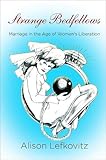Strange Bedfellows : Marriage in the Age of Women's Liberation / Alison Lefkovitz.
Material type: TextSeries: Politics and Culture in Modern AmericaPublisher: Philadelphia : University of Pennsylvania Press, [2018]Copyright date: ©2018Description: 1 online resource (280 p.) : 8 illusContent type:
TextSeries: Politics and Culture in Modern AmericaPublisher: Philadelphia : University of Pennsylvania Press, [2018]Copyright date: ©2018Description: 1 online resource (280 p.) : 8 illusContent type: - 9780812295054
- Domestic relations -- United States -- History -- 20th century
- Marriage law -- United States -- History -- 20th century
- Marriage -- United States -- History -- 20th century -- Public opinion
- Marriage -- United States -- History -- 20th century
- HISTORY / United States / 20th Century
- American History
- American Studies
- Gender Studies
- Law
- Women's Studies
- 306.810973 23
- HQ535 .L36 2018
- online - DeGruyter
| Item type | Current library | Call number | URL | Status | Notes | Barcode | |
|---|---|---|---|---|---|---|---|
 eBook
eBook
|
Biblioteca "Angelicum" Pont. Univ. S.Tommaso d'Aquino Nuvola online | online - DeGruyter (Browse shelf(Opens below)) | Online access | Not for loan (Accesso limitato) | Accesso per gli utenti autorizzati / Access for authorized users | (dgr)9780812295054 |
Frontmatter -- Contents -- Introduction -- Chapter 1. The Problem of Marriage in the Age of Women’s Liberation -- Chapter 2. The End of Breadwinning and Homemaking -- Chapter 3. Blaming Feminism for the Fragile Family -- Chapter 4. Race, Welfare, and Marriage Regulation -- Chapter 5. Sham Marriages, Real Love, and Immigration Reform -- Chapter 6. Gay Marriage and “Homosexual Households” -- Conclusion. The End of Marriage as We Know It -- Notes -- Index -- Acknowledgments
restricted access online access with authorization star
http://purl.org/coar/access_right/c_16ec
In the inaugural issue of Ms. Magazine, the feminist activist Judy Syfers proclaimed that she "would like a wife," offering a wry critique of the state of marriage in modern America. After all, she observed, a wife could provide Syfers with free childcare and housecleaning services as well as wages from a job. Outside the pages of Ms., divorced men's rights activist Charles Metz opened his own manifesto on marriage reform with a triumphant recognition that "noise is swelling from hundreds of thousands of divorced male victims." In the 1960s and 70s, a broad array of Americans identified marriage as a problem, and according to Alison Lefkovitz, the subsequent changes to marriage law at the state and federal levels constituted a social and legal revolution.The law had long imposed breadwinner and homemaker roles on husbands and wives respectively. In the 1960s, state legislatures heeded the calls of divorced men and feminist activists, but their reforms, such as no-fault divorce, generally benefitted husbands more than wives. Meanwhile, radical feminists, welfare rights activists, gay liberationists, and immigrant spouses fought for a much broader agenda, such as the extension of gender-neutral financial obligations to all families or the separation of benefits from family relationships entirely. But a host of conservatives stymied this broader revolution. Therefore, even the modest victories that feminists won eluded less prosperous Americans—marriage rights were available to those who could afford them.Examining the effects of law and politics on the intimate space of the home, Strange Bedfellows recounts how the marriage revolution at once instituted formal legal equality while also creating new forms of political and economic inequality that historians—like most Americans—have yet to fully understand.
Mode of access: Internet via World Wide Web.
In English.
Description based on online resource; title from PDF title page (publisher's Web site, viewed 04. Okt 2022)


